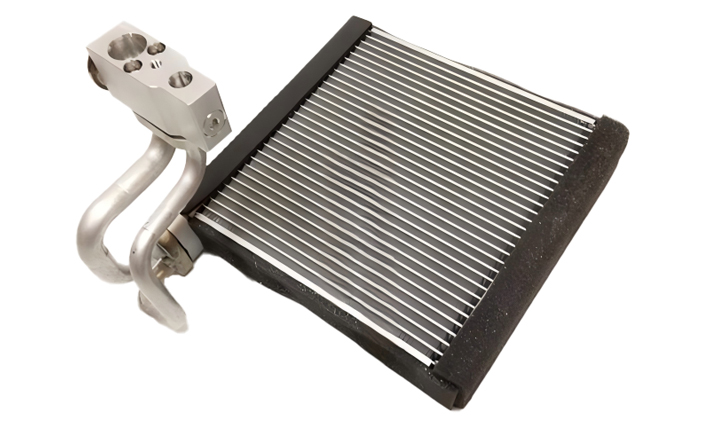Evaporator with Integrated TXV Assembly: The Hassle-Free Choice Explained.
2025-07-04
In the installation and maintenance of refrigeration and air conditioning systems, "hassle-free operation" is a top priority for both engineers and users. The traditional approach requires field assembly and connection of separate evaporator and thermal expansion valve (TXV) components—a process prone to complexity and errors. So, does pre-integrating these components into a single "Evaporator with TXV Assembly" at the factory truly deliver a more worry-free experience? The answer is a definitive yes, with benefits spanning the entire system lifecycle.

Part 1: Core Components Working in Harmony – Precision Flow Control for Cooling
Understanding the assembly's advantages starts with knowing the roles of its key parts:
1. Thermal Expansion Valve (TXV): Acts as the "flow regulator" in the refrigeration cycle. Its core functions are to throttle and reduce the pressure of high-pressure liquid refrigerant from the condenser and precisely control the refrigerant flow rate entering the evaporator. It automatically adjusts its opening by sensing superheat (the temperature increase of refrigerant vapor above its saturation temperature) at the evaporator outlet. This ensures the evaporator absorbs heat efficiently while preventing liquid refrigerant from flooding back and damaging the compressor.
2. Evaporator: Serves as the "heat absorption core" of the cycle. Low-pressure, low-temperature liquid refrigerant absorbs heat from the passing medium (air or water), evaporates, and achieves the cooling or dehumidification goal. Its heat exchange efficiency directly determines the system's overall cooling performance.
The precise matching of the TXV to the evaporator is critical for efficient and stable system operation.
Part 2: Integrated Assembly – Comprehensive Hassle-Free Advantages
Compared to field assembly of separate parts, the pre-integrated assembly delivers significant benefits across key stages:
1. Faster, Simpler Installation:
Streamlined Process: Onsite technicians no longer need to separately position the TXV, carefully bend tubing, or perform complex threading, flaring, or brazing connections. The assembly arrives as a single unit, typically requiring only connection of the liquid/vapor lines and mounting of the sensing bulb (if applicable), drastically reducing installation time.
Reduced Skill Dependency: Lowers the requirement for highly skilled installers, minimizing the risk of early failures caused by field errors (e.g., reversed connections, improper torque, poor brazing).
2. Enhanced Seal Integrity, Reduced Leak Risk:
Factory Precision: The critical connection between the evaporator and TXV (usually a high-reliability braze joint) is completed under controlled factory conditions with strict quality standards. This results in far superior sealing compared to field-made connections.
Fewer Potential Leak Points: Significantly reduces the most common potential leak sources in the system. Field assembly adds at least two connection points, whereas the integrated assembly eliminates these vulnerabilities, enhancing overall system integrity.
3. Optimized Performance, Efficient Operation:
Pre-Matched at Factory: Manufacturers ensure the TXV's capacity, superheat setting, and other parameters are perfectly calibrated to the evaporator's thermal performance during the assembly design phase. This eliminates efficiency losses (like inadequate cooling or increased energy consumption) caused by field selection errors or component mismatch.
Optimized Refrigerant Distribution: The integrated design promotes more uniform refrigerant distribution across the evaporator coils, improving overall heat transfer efficiency.
4. Simplified Maintenance & Quicker Replacement:
Streamlined Diagnosis & Service: When system issues like poor cooling performance suggest a fault within the evaporation/expansion circuit, diagnosis naturally focuses on the entire assembly. Replacement involves swapping the entire unit, which is significantly faster and simpler than individually removing/replacing components, reconnecting lines, leak testing, evacuating, and recharging refrigerant.
Minimized Contamination Risk: Replacing the entire assembly reduces the time the system is open to the atmosphere during service, effectively lowering the risk of moisture and contaminant ingress.
Part 3: Key Considerations When Choosing an Integrated Assembly
While the advantages are compelling, consider these factors:
1. Initial Cost: Pre-integrated assemblies typically have a higher purchase price than buying evaporators and TXVs separately. However, it's crucial to evaluate the total cost of ownership (TCO), factoring in savings from reduced installation labor, lower leak risks, decreased failure rates, and improved maintenance efficiency over the system's lifespan.
2. System Compatibility: It is essential to ensure the assembly's specifications (refrigeration capacity, connection sizes, refrigerant type) are fully compatible with the system's other core components (compressor, condenser) and the actual operating conditions (ambient temperatures, load profile).
3. Handling & Protection: As a precision-integrated component, extra care is needed during shipping, handling, and storage to prevent damage to connections, valve bodies, or fins. Choosing suppliers with robust packaging and a solid reputation is vital.
Summary
For applications prioritizing installation speed, operational reliability, and maintenance simplicity, the Evaporator with Integrated TXV Assembly is undoubtedly the more hassle-free solution. By leveraging factory precision integration, it dramatically simplifies installation, significantly reduces leak risks, guarantees optimal component matching, and enhances service efficiency. Although the initial investment may be slightly higher, the comprehensive lifecycle benefits – saving time, labor, hassle, and ensuring reliability – make it the intelligent choice for elevating overall refrigeration system quality and user experience.